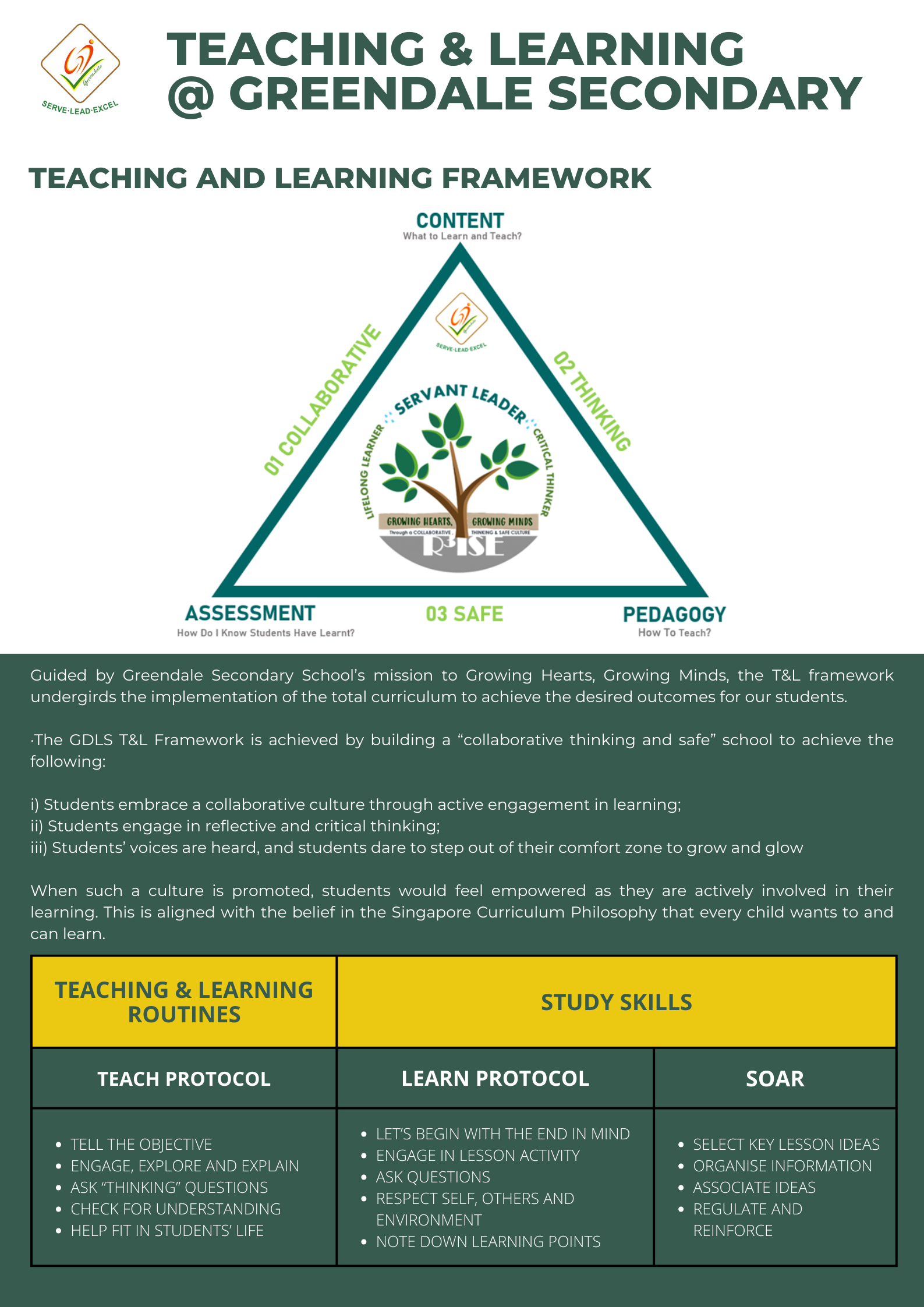Instructional Programme

Introduction
-
Guided by Greendale Secondary School’s mission to nurture talents, develop character and inspire lives, the updated 2021 T&L Framework (TLF) undergirds the implementation of the total curriculum to achieve the desired outcomes for our students.
-
The framework identifies the key enablers to be adopted by all staff to help our students meet their learning goals and aspirations. With school values as our core foundation, all staff and students aspire towards our vision of developing Committed Learners, Critical Thinkers and Confident Leaders.
-
At the core of the TLF is the belief that all students can learn and succeed. This is aligned with the belief in the Singapore Curriculum Philosophy that every child wants to and can learn.
Key components
-
The school places a strong emphasis on delivering a holistic curriculum. This component in the TLF addresses the student learning outcomes it seeks to realise. With a clear understanding of the educational intent of and disciplinary principles guiding the national syllabuses, we can help students develop the intended dispositions, skills and knowledge to become lifelong learners equipped with 21st century competencies to thrive in a VUCA (volatile, uncertain, complex, ambiguous) world. Through further customisation and differentiation of what is learnt and taught from the national syllabuses, based on students’ learning needs and strengths, we can achieve authentic and deep learning.
-
The “Pedagogy” component serves to highlight that teachers have the autonomy to also customise and differentiate how we would like to enact the curriculum to realise the intended student outcomes. In this component, we carefully design and organize learning experiences that are useful in attaining the educational goals set out in the “Content” component. For learning to be effective, we adapt our teaching pace, approaches and practices – informed by well-researched theories and processes related to students, learning and teaching from the Singapore Teaching Practice and beyond. Students are empowered to construct knowledge actively and when they find meaning in learning, they are motivated to take ownership of learning as self-directed learners.
-
Assessment. We recognize that assessment is an integral part of teaching and learning and it supports students’ holistic development, including becoming self-directed There should be a balance of assessment for and of learning. As such, we design assessments with clarity of purpose, to provide feedback for students to bridge learning gaps and teachers to improve teaching practices. Based on students’ learning needs and strengths, we plan and enact learner-centred and balanced assessment. This creates a learning path to support and enhance learning, improve students’ engagement and motivation, ultimately bringing about higher achievement and greater confidence to learn.
-
Teaching and Learning (T&L) routines as Study Skills (SS). To support the enactment of the TLF, the school has developed a set of school and department-based T&L routines as well as SS. The school-based T&L routines and SS aim to provide broad-based tools and processes to guide teachers and students. Building upon these, individual departments are empowered to customize the T&L routines and SS to suit the needs of the students and curriculum. (For example, in the CCE curriculum, the Multi-Dimensional Framework is adopted to help students take on different perspectives when analyzing an issue.) The implementation of the T&L routines and SS is also part of the school’s effort to help students discover their strengths and develop into self-directed learners. (For example, students learn study skills such as note-taking and using mind-maps / concept maps to summarise their learning. Some students learn better when they take their own customized notes while others learn more effectively when using teachers’ notes as a base and adding on their own annotations and diagrams.) With exposure to these T&L tools, students discover their learning preferences and strengths. When students are equipped with the relevant routines and skills, teachers can gradually release their responsibility on learning and students can learn independently and effectively.
-
In line with the national initiatives such as Personalised Digital Learning Programme (PDLP) and Blended Learning, a key enabler in the area of digital technologies has been included in the TLF so that we can tap on the affordances of technology to better support teachers and students. In particular, these can help equip students with stronger abilities, skills and habits for independent and lifelong learning, as well as strengthen their future readiness.

